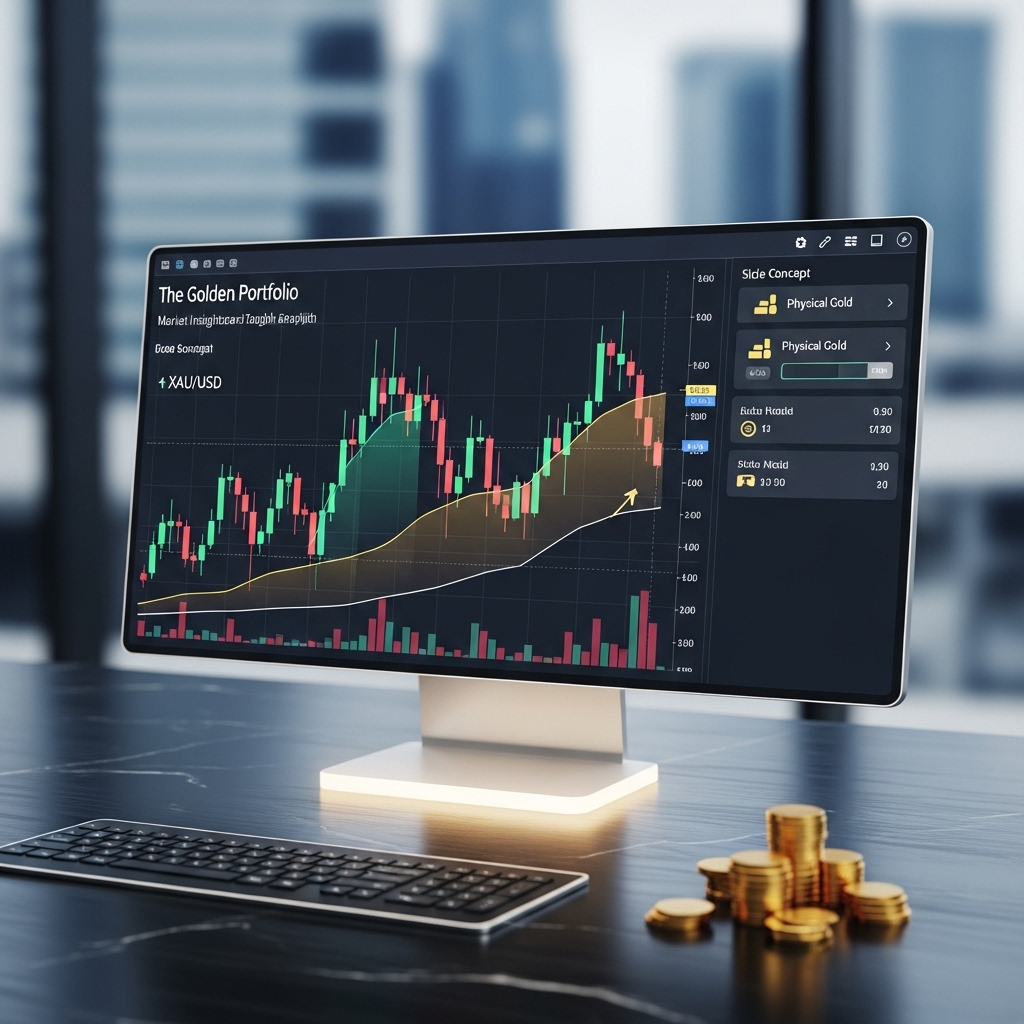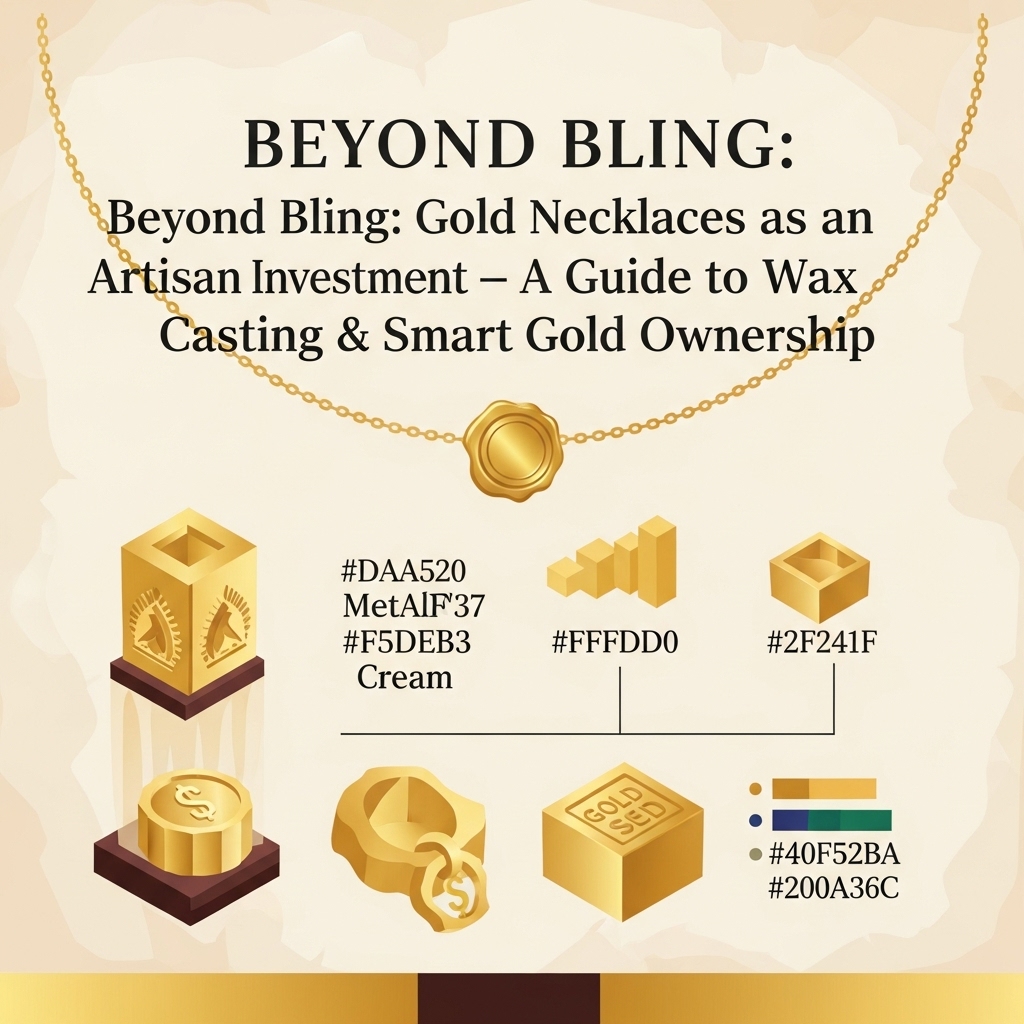Beyond Bullion: Crafting Investment Value with Gold Necklaces
With gold captivating investors as a premier inflation hedge and safe-haven asset, its recent market performance has solidified its appeal. Many are now exploring tangible, value-added avenues to engage with this precious metal beyond traditional holdings. What if your gold investment could also embody creative value, tangible beauty, and entrepreneurial potential?
This post unveils a unique approach for gold investors: making exquisite gold necklaces through small-scale wax casting. We’ll guide you through the artisan journey, from design and wax model creation to the precise art of casting and finishing. Our aim is to illustrate how this ancient technique transforms raw gold into highly desirable, value-added assets with significant market appeal.
For the astute gold investor, this process offers distinct financial advantages. It allows you to significantly enhance gold’s intrinsic value beyond its spot price via skilled craftsmanship, directly tapping into the lucrative bespoke jewelry market. This hands-on method provides a compelling way to diversify physical gold holdings, creating beautiful, wearable assets that blend material worth with artistic value. This guide is for investors ready to merge financial strategy with artisan skill, turning a strategic asset into a profitable, tangible creation.
Gold Market Analysis and Key Insights
Gold has historically served as a critical asset, offering a hedge against inflation and currency devaluation. For artisans, understanding its market dynamics is vital for pricing and managing raw material costs.
Global Economic Influence
Gold’s price is heavily influenced by global macroeconomic factors. As a safe-haven asset, demand typically rises during geopolitical instability, high inflation, or economic downturns. Central bank purchasing, particularly from emerging economies, is a significant driver, reflecting diversification from fiat currencies.
Demand and Supply Dynamics
The gold market balances various demands: jewelry (the largest segment, especially in Asia), investment (bars, coins, ETFs), and industrial applications. Supply comes from mine production and recycling; disruptions in either can impact prices.
Currency Valuation Impact
The U.S. Dollar’s strength often inversely affects gold prices. A weaker dollar makes gold cheaper for international buyers, potentially boosting demand.
Current Gold Market Trends and Data
Recent years have seen gold achieve new nominal highs, driven by persistent inflation, geopolitical tensions, and robust central bank accumulation. Despite rising interest rates, gold’s appeal as a wealth preserver sustains demand, demonstrating resilience. While short-term volatility is expected, the long-term market sentiment for gold remains positive.
Investment Benefits and Considerations
Investing in gold, whether as bullion or via value-added products like handcrafted necklaces, offers portfolio diversification and acts as an excellent store of value, safeguarding purchasing power. However, gold is a non-yielding asset (no dividends/interest), and physical gold incurs storage/insurance costs.
Expert Recommendations
Financial experts recommend gold as a long-term strategic asset within a diversified portfolio, typically allocating 5-10%. Artisans should view their raw gold not just as material but a tangible investment. Consider dollar-cost averaging for purchases to mitigate price volatility. Always consult a financial advisor to align gold investments with personal financial goals.

Gold Investment Strategies and Options
For the small-scale artisan, gold isn’t merely a raw material; it’s also a potential investment, offering unique financial opportunities. Understanding its various forms can significantly enhance your financial resilience and business strategy.
Different Gold Investment Options and Strategies:
1. Physical Gold:
* Raw Materials: Your existing inventory of gold grain, sheet, or wire inherently represents a direct physical gold holding. This provides direct control and acts as a natural hedge against fluctuations in your material costs.
* Bullion: Investing in high-purity gold bars or widely recognized coins (e.g., American Gold Eagles, Canadian Maples) offers a direct, tangible store of value. These are globally recognized and generally liquid, though they require secure storage.
* Collectible/High-Purity Jewelry: While most finished jewelry primarily serves as a consumer good, exceptionally high-purity pieces or unique artisan creations can retain significant intrinsic gold value, potentially appreciating as collectibles.
2. Paper Gold:
* Gold Exchange Traded Funds (ETFs): These funds track the price of gold, allowing you to invest without the complexities of physical storage. ETFs offer liquidity and convenience but involve management fees and counterparty risk.
* Gold Mining Stocks: Investing in companies that mine gold provides leveraged exposure. Their stock prices can amplify gold price movements but also carry company-specific operational and management risks separate from the commodity itself.
Risk Assessment and Portfolio Allocation:
Gold traditionally serves as a hedge against inflation and economic uncertainty, diversifying your assets. However, its price can be volatile. As an artisan, your business inventory already constitutes a significant gold allocation. For personal investment, consider diversifying with a small to moderate percentage (e.g., 5-15%) in physical bullion or gold ETFs, balancing potential gains with your liquidity needs and risk tolerance.
Comparison of Investment Methods and Market Timing:
Physical gold offers tangibility and no counterparty risk but incurs storage costs and can be less liquid for small transactions. ETFs are highly liquid and convenient but lack physical ownership. Mining stocks offer growth potential but higher overall risk. Market timing is notoriously challenging; instead of trying to predict price peaks and troughs, a long-term strategy like dollar-cost averaging—investing a fixed amount regularly regardless of current price—can smooth out fluctuations and mitigate timing risk, aligning well with a steady artisan business approach.
Market Performance and Outlook
The market for small-scale gold jewelry crafting, the target of ‘Making Gold Necklaces with Wax Casting’, has demonstrated enduring historical performance. Traditionally a niche sector, demand for artisan skills and bespoke gold pieces has consistently re-emerged during periods emphasizing craftsmanship, personalization, and independent entrepreneurship.
Currently, the landscape is robust, significantly buoyed by the burgeoning e-commerce platforms and social media, which empower small artisans to reach global audiences. Consumers increasingly seek unique, handmade, and ethically sourced items, fostering substantial growth in the independent jewelry designer space. This guide is perfectly positioned to empower individuals to capitalize on this trend.
The future outlook remains highly positive. The ‘maker’ economy continues its expansion, driven by desires for personalized luxury and sustainable consumption. As mass-produced items lose their appeal, the allure of handcrafted gold pieces will likely intensify.
Profitability for these artisans is intrinsically linked to gold prices. Gold traditionally acts as a safe-haven asset, appreciating during economic uncertainty, inflation, and geopolitical instability. Fluctuations in interest rates and currency values also significantly impact its cost. Artisans must vigilantly track these global economic indicators to manage material expenses, set competitive pricing, and ensure sustainable business growth within this dynamic and lucrative market.
Frequently Asked Questions About Gold Investment
Is crafting gold necklaces through wax casting a sound gold investment strategy?
Crafting adds artistic and labor value, increasing retail price. However, as direct gold investment, it’s less liquid than bullion. Returns depend on material cost plus design premium, which may not track gold spot prices. Pure gold investment favors bars or coins.
How does the purity of gold used in these techniques affect its investment value?
Purity (karatage) directly dictates intrinsic value. Higher karats (e.g., 24K) have more pure gold, tracking spot prices but are softer. Common jewelry (14K, 18K) uses alloys for durability, reducing per-gram investment appeal. For resale, gold content is paramount.
Can I use existing gold holdings (e.g., old jewelry, scrap) for casting, and what are the investment implications?
Yes, using existing gold is cost-effective. However, accurately assess its purity; mixed karats or unknown alloys affect casting and final piece value. Professional assaying confirms exact gold content, crucial for investment integrity.
What about the liquidity and resale value of artisan-crafted gold necklaces compared to standard gold bars or coins?
Artisan necklaces command a design premium, but this added value is less liquid. Gold dealers typically pay melt value, not artistic premium. Recouping design value requires selling to private buyers or specialized jewelry markets, which can take longer.
Are there specific hallmarking or certification requirements to maintain the investment integrity of my finished pieces?
Yes, hallmarking (stamping purity like 14K, 18K) is crucial. While not always legally required, it builds buyer confidence and verifies gold content, essential for resale. Independent assay certification can bolster investment integrity for high-value pieces.

Final Thoughts on Gold Investment
This artisan’s guide to wax casting gold necklaces isn’t just about crafting; it profoundly illuminates gold’s multi-faceted value for investors. You’ve seen how raw gold transforms into bespoke, high-value art, underscoring its enduring appeal beyond a mere commodity. This process highlights gold’s inherent tangibility, its role in wealth preservation, and its potential for significant value addition through skilled craftsmanship.
For gold investors, this means appreciating gold’s utility in creating tangible assets that blend intrinsic metal value with artistic premium. Gold remains a cornerstone for portfolio diversification and wealth protection. Consider not only holding physical gold but also the immense potential within the artisan gold market. Dive deeper into the world of gold, whether through investment, exploration of craftsmanship, or simply appreciating its timeless allure.